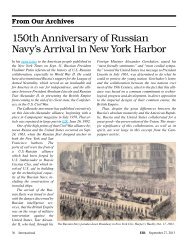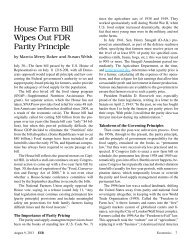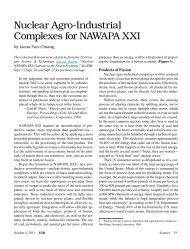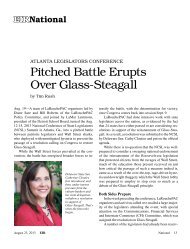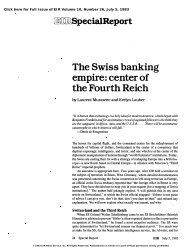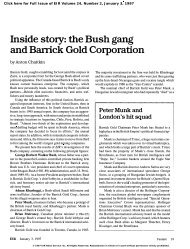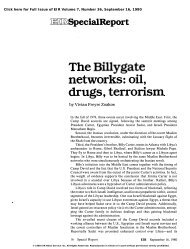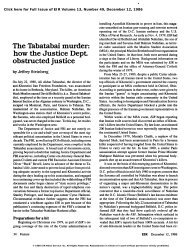View Full Issue - Executive Intelligence Review
View Full Issue - Executive Intelligence Review
View Full Issue - Executive Intelligence Review
Create successful ePaper yourself
Turn your PDF publications into a flip-book with our unique Google optimized e-Paper software.
Figure 1, taken from the North American Electric Relia<br />
bility Council (NERC) and based on a survey of utilities,<br />
demonstrates the degree of uncertainty the industry places on<br />
its own forecasts . If peak demand increases more than fore<br />
cast, and projected available resources do not come through<br />
by 1992, demand could easily outstrip available resources.<br />
In addition, the basis for the low , 2% per year projected<br />
increase in electric demand is an assumption of continued<br />
real economic stagnation that has put the annual increase in<br />
electricity demand at one-third that of the 196Os . The only<br />
reason the real state of the electrical industry has not been<br />
apparent so far, is the collapse of growth in demand in the<br />
industrial sector.<br />
If there were any resumption of real economic growth<br />
not in hamburger stands , but in energy-intensive agriculture<br />
and industry-there would be an immediate shortage of elec<br />
tric power. Because it takes at least eight years to put new<br />
'baseload generating capacity in service , years of curtailed<br />
service could be the result.<br />
For this summer, if the heat wave and dry weather con<br />
tinue, it is likely there will be an increase in unscheduled<br />
outages and voltage reductions, and perhaps breakdowns of<br />
equipment running at or above rated capacity for long periods<br />
of time. This nation has been eliminating the level of redun<br />
dancy in the electric system that gives us a "defense in depth"<br />
against temporary , "abnormal" conditions , and provides for<br />
longer-term economic growth .<br />
Before the end of this century , the prospect of people in<br />
the United States living like those in cities in developing<br />
nations-with perhaps three or four hours of electricity per<br />
EIR August 5, 1988<br />
A utility company put on<br />
this exhibit in the Jimmy<br />
Carter era, promoting the<br />
Alice in Wonderland idea<br />
that "conservation" is<br />
somehow a "source" of<br />
energy. The Reagan<br />
administration promotes<br />
the same policy under the<br />
guise of "cost<br />
effectiveness. "<br />
day-will become the tragic reality of a nation that allowed<br />
itself to be ruled by irrationality.<br />
Why electricity is unique<br />
Unlike any other commodity , electricity has to be con<br />
stantly produced to be delivered instantaneously, because it<br />
cannot yet be economically stored. Therefore , utilities do not<br />
shut down for weekends or holidays, and their systems must<br />
function all the time. In order to make sure uninterrupted<br />
service is provided, utilities must keep on hand a reserve<br />
margin of generating capacity. This reserve margin is related<br />
to , though not identical with, megawatts of additional capac<br />
ity . Historically , a reserve margin of 21 % has been consid<br />
ered adequate .<br />
This margin is not "extra," even though no-growth mal<br />
thusians have tried to convince the American public that U. S.<br />
utilities have oodles of power plants they do not really need,<br />
because they do not run them all at once. Power plant equip<br />
ment has to be shut down periodically for scheduled mainte<br />
nance. At times, there are unscheduled shut -downs , if a piece<br />
of equipment unexpectedly needs repair. But the overall sys<br />
tem must still continue to function.<br />
Unlike most consumer goods , there are significant swings<br />
in consumer electric demand , generally related to the ex<br />
tremes of weather in both the winter and summer. Utility<br />
companies must be able to meet these temporary surges in<br />
demand without any interruption in service. When the con<br />
sumer is sweltering in 100-plus degree heat, or suffering in<br />
below-zero cold, he is not interested in a list of excuses as to<br />
why his lights , air conditioning , or heat cannot be turned on .<br />
Feature 23





